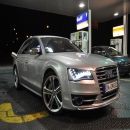Dołączył(a): 23.lip.2003 19:25:03
Posty: 11651
Lokalizacja: Wrocław
|
widac ze fotki sa tendencyjne 
prawda wyglada nieco inaczej - pozwol ze przytocze fragment po angielsku:
The hard facts on Philips 6000K Ultinon:
Marketing names: "Ultinon", "Cool Power" and "Cool White" are all the same D2 lamps.
The Ultinon and standard lamps are identical with the visible exception of the 'salts' colour in the burner and the ceramic insulation on the earth return lead. Base is labeled: "Not legal for use in Europe/USA". This bulb is clearly ment for the Asia/Japanese marked - they do not have the strict regulations when it comes to color. Some aftermarked vendors market Ultinon as a brighter bulb than a standard D2. This is not true:
OEM Philips D2S is 3200lm bright (+/-450lm) and 4100K colortemp (0.380x 0.390y). (For comparison)
Philips Ultinon D2S is 2400lm bright (+/-250lm) and 5800K colortemp (0.327X 0.312Y).
6000K, 7000K, 15000K HID bulb scam
Many people said, "oh no, not another blue bulb!", and thought that the blue low quality bulb "scam" finally spread over to hit the real HID market in late 2001. Philips Ultinons made in Germany have equal quality, like the OEM Philips bulb, so you cant really call that product a scam.
There are other blue HID bulbs made other places in the world that can be scam products. They maybe even have the Philips or Osram name on the box, or the base, but bulbs are made or modified by someone else. Equal bulbs can also be markeded to have different color temperature. Most customers would never know if color temp was was off, as long as they are matched as a pair. Some kit and bulb suppliers advertise with 7000K and higher. This can be suspective because a lower than OEM quality bulb can have been used. No bulb OEM manufacturer makes any versions with more than ~6000K. So either it is 6000K, or the bulb might have been painted. Painting bulbs decreases brightness and in most cases decreases life. So be aware what you are buying.
As an example, look at table below, and see how blue a 9000K bulb will be! Would you honestly want it to be as blue as the sky?
Yellow:
1500 k Candlelight
2700-2900 k Yellow painted fog halogen bulbs
-------------------------------
Yellowish white:
3200 k Sunrise/sunset
3200 k Premium H7 non painted halogen bulb
3400 k 1 hour from dusk/dawn
-------------------------------
White:
4100 k Philips/Osram OEM HID D2S
5500 k Bright sunny daylight around noon
----------------
Blueish white
5500-5600 k Electronic photo flash
6000 k Philips Ultinon HID D2S
6500-7500 k Overcast sky
-----------------
Blue:
9000-12000 k Blue sky
-----------------
Purple:
28000 Northern sky
12000-30000 k Ultra Violet light (black light)
---------------------------------
Above table is based on the ancient Kelvin (K) colortemp defined along time ago. Before we knew that was electro magnetic waves. At that time we only knew the temperature something had when burning. As an example, a candle light burns at around 1500K (see table above) or 2100F (Fahrenheit) or 1200C (Celsius).
Interesting! So what is actually white light?
Now that you know that light is electro magnetic waves, imagine that each base color (blue, green, yellow and red) has each wave length. White light is a balanced mix of all of them. Here is the window that are visible with human eyes:
720nm infra red - heat radiation (invisible)
660nm red
610nm yellow
550nm green
460nm blue
420nm black light
400nm ultra violet (invisible)
1nm = 0.000000001 meter
What are the results of using 6000K, 7000K, 15000K HID bulbs?
Stage 1 refers to 4100K and stage 2 normally refers to something higher value K.
As an example, a 6000K bulb in some headlamps might not show much difference at all, others will look more blue. These are observations when standing in front of the car looking into the headlights from above. After getting over the initial thrill of cooler light, many drivers have noticed that important traffic information are not as appearant as with OEM standard bulb. White traffic signs is being lit too much and can feel glaring.
During winter 2002, exponensional use of Kelvin (K) rating is used as brightness improving advertisement. Its all just big empty words. Do a search for "kelvin color temperature" on a search engine (ie: yahoo.com) and you will see that it has nothing to do with brightness and all to do with color. Going upwards from 4100K means that your light turns blue at the expense of total brightness and yellow color. Theoretically, if the same brightness were to be kept, you would have to increase the wattage of the bulb from 35 to maybe 40W, and redesign the ballast. This would be a very costly solution, so thats pretty much why all automotive HID bulbs are 35W.
reasumujac - niebieskie nie oznacza jasne 
_________________
było:
Q7 4M 3,0 TFSI
SQ5 Plus
A7 C7 3,0 biTDI
A6 C7 3,0 biTDI
S4 B8 3,0 TFSI
V8 D11 4,2
A4 B6 1,8T q
S8 D2 4,2
S6 C4 4,2
A6 C4 2,5 TDI q
S6 C4 2,2T
A6 C4 2,5 TDI q
A80 B4 1,9 TDI
|
|






 A8:
A8:  S8:
S8: 










